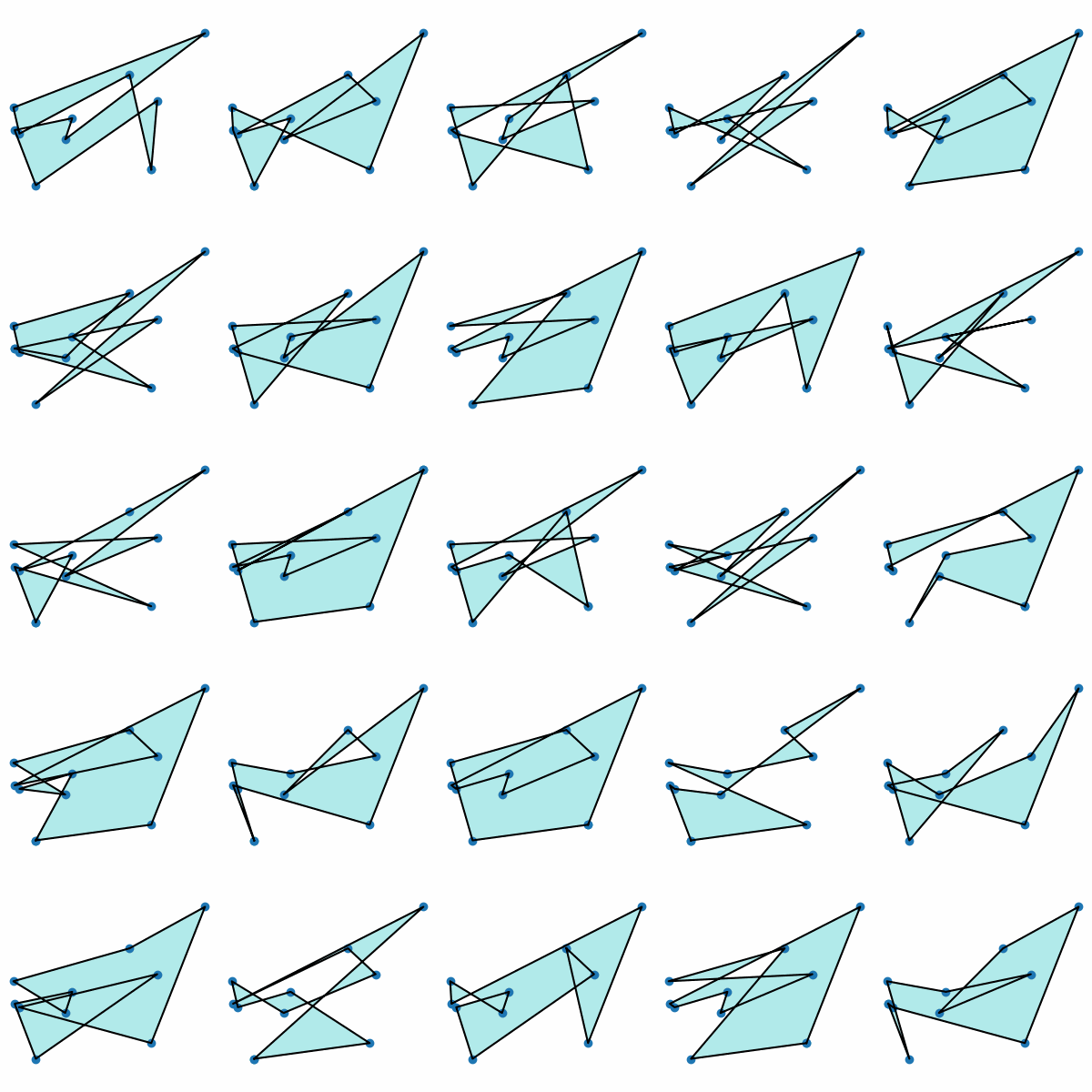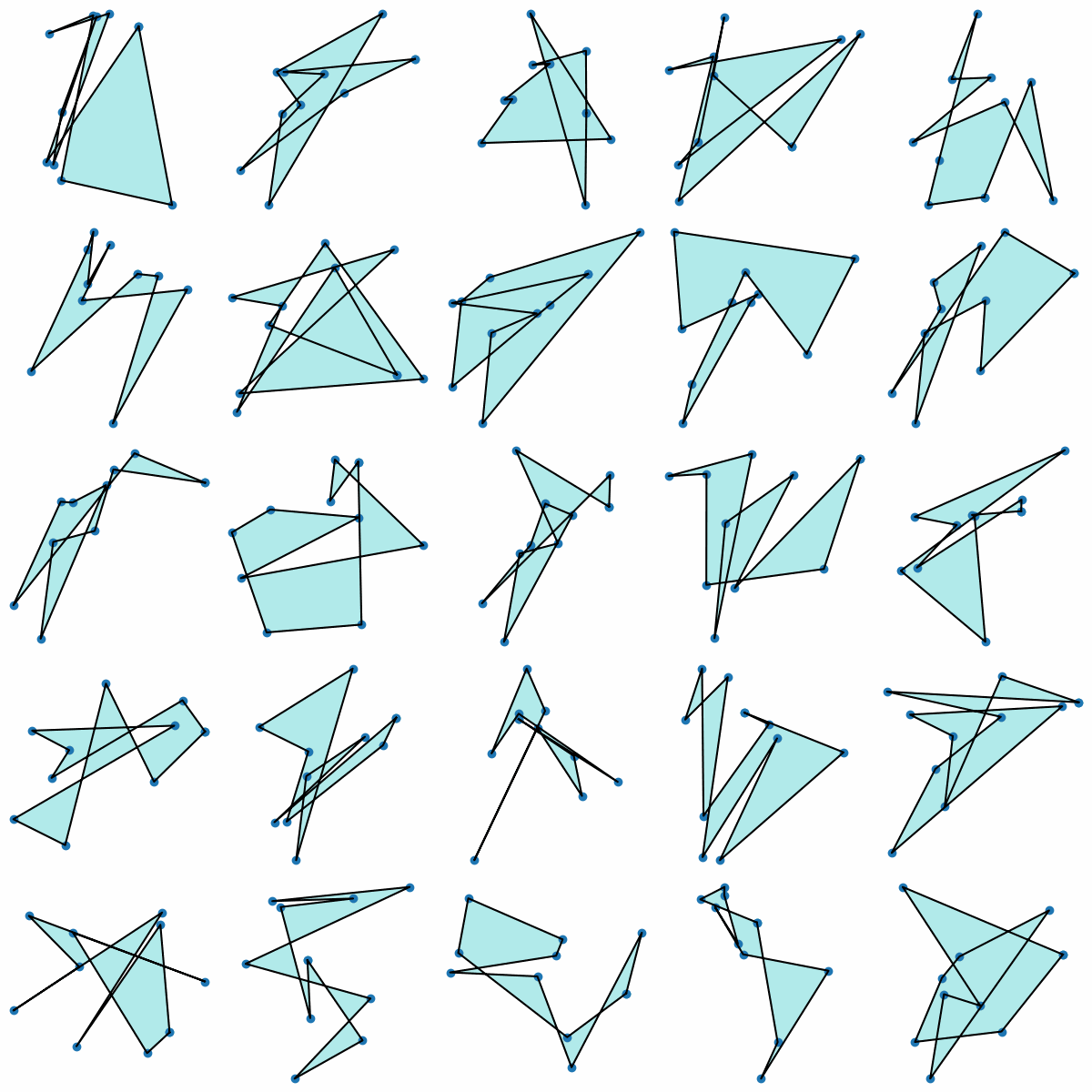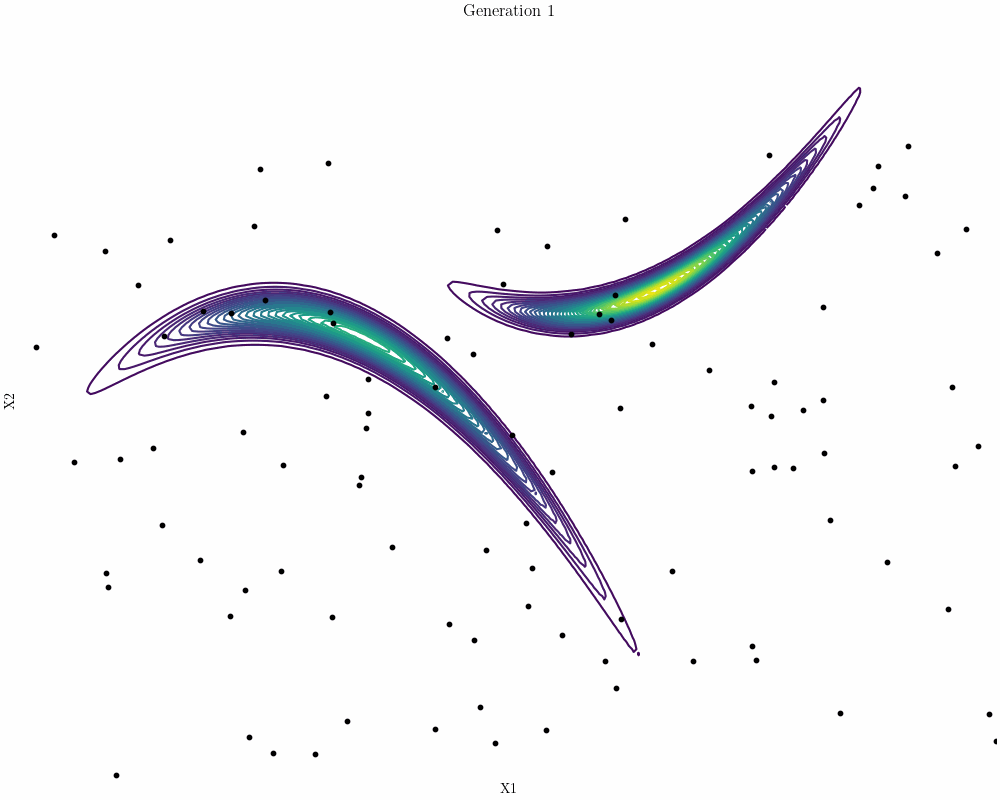Genetic algorithm from scratch
This post details the implementation of a genetic algorithm from scratch and provides a number of visual examples to help develop the readers understanding. In addition to exploring the core concepts of genetic algorithms, this post places a strong emphasis on the importance of good object-oriented programming (OOP) practices and effective abstraction. Carefully designed abstractions are the key to writing usable and extensible software.
Genetic algorithms are a class of heuristic optimisation techniques that mimic the process of natural selection. Beginning with a population of candidate solutions (or individuals), from which the best solutions (fittest individuals) are selected for reproduction (survival of the fittest). The fittest individuals produce offspring that form a new population (generation). The fittest individuals in each new generation are selected for breeding, and the process is repeated over many generations, leading to the emergence of increasingly optimal solutions.
All the code and examples are available in the following repo: pyga
Implementation
By implementing a genetic algorithm with a clean object-oriented design, we can create a flexible and reusable framework that separates concerns and is adaptable to various optimisation problems without having to rewrite the core evolutionary logic.
A genetic algorithm can be broadly decomposed into the following logical units:
GeneticAlgorithm: A class that controls the evolutionary process.Population: A class that represents a generation of individuals.Individual: A class that represents a candidate solution and encapsulates its genetic representation and fitness evaluation.crossover(individual, partner): A function that combines the genes of two individuals to produce new offspring.mutate(individual): A function that randomly mutates the gene of an individual in order to maintain diversity in the gene pool.
We provide a high-level overview of the implemented classes, focussing on their design and interactions. For the sake of simplicity, the code used to generate the animations and figures is omitted but can be found in the repo.
GeneticAlgorithm
The GeneticAlgorithm class controls the evolutionary process. The user must provide an initial population from which the evolutionary process starts. The user can also define the number of generations num_generations and number of parents num_parents used for generating offspring. The optimisation process is initiated by calling evolve.
class GeneticAlgorithm:
def __init__(
self,
population,
num_generations=50,
num_parents=4,
mutation_probability=0.05
):
self.population = population
self.num_generations = num_generations
self.num_parents = num_parents
self.mutation_probability = mutation_probability
self.fitness = []
def _generate_offspring(self):
"""
Generate a new population by combining genetic material
from selected parents (high-fitness) and applying random
mutations to their offspring
"""
new_population = []
for _ in range(len(self.population.individuals)):
parent_a, parent_b = random.sample(self.population.parents, 2)
child = parent_a.crossover(parent_b)
child.mutate(self.mutation_probability)
new_population.append(child)
self.population.individuals = new_population
def _evolutionary_cycle(self):
"""
Executes one iteration of the evolutionary process:
- Evaluate the fitness of the population
- Select parents for reproduction
- Generates offspring to form the next generation
"""
self.population.evaluate()
self.fitness.append(max(self.population.fitness))
self.population.select_parents(self.num_parents)
self._generate_offspring()
def evolve(self):
"""
Runs the genetic algorithm for the specified number
of generations.
"""
for _ in tqdm(range(self.num_generations), desc="Evolution"):
self._evolutionary_cycle()
Population
The Population class represents all individuals within a single generation. Methods are provided for evaluating the fitness of all individuals and selecting parents for reproduction.
Evaluating the fitness of each individual in the population is an embarrassingly parallel process. In the below implementation, the evaluate method computes the fitness of every individual in serial; however, this process could be easily parallelised on a traditional cluster or cloud infrastructure.
class Population:
def __init__(self, individuals):
self.individuals = individuals
self.fitness = []
self.parents = []
def evaluate(self):
"""
Evaluate the fitness of every individual in the population
"""
self.fitness = [individual.fitness() for individual in self.individuals]
def select_parents(self, num_parents):
"""
Rank individuals by fitness and select the strongest for reproduction
"""
self.parents = sorted(
self.individuals, key=lambda x: x.fitness(), reverse=True
)[:num_parents]
Individual
The Individual class represents a candidate solution and encapsulates its genetic representation and fitness evaluation. It serves as a base class, allowing subclasses to define problem-specific fitness functions. By inheriting from Individual, custom implementations can be created for various optimisation problems, making the package adaptable to different domains. Users must define the _crossover_method and _mutation_method when subclassing Individual. This is discussed further in the following section.
The Individual class essentially functions as an interface to the optimiser. The clear separation of concerns between the Individual and the optimisation routine enables the user to address any problem for which a genetic representation and fitness measure can be defined with ease.
class Individual:
_crossover_method = None
_mutation_method = None
def __init__(self, genes):
self.genes = genes
self._fitness = None
def evaluate_fitness(self):
"""
This method should be implemented in subclasses to evaluate fitness.
"""
raise NotImplementedError
def fitness(self):
"""
Returns the fitness of the individual. Computes fitness if it has not
been computed yet.
"""
if self._fitness is None:
self.evaluate_fitness()
return self._fitness
def crossover(self, partner):
"""
Crossover: combine the genetic material of two parent individuals
to create offspring
Returns
-------
child
"""
if self._crossover_method is None:
raise NotImplementedError("Crossover method not defined.")
return self._crossover_method(self, partner)
def mutate(self, mutation_probability):
"""
Mutation: introduce small variations in the genetic material,
preventing premature convergence and maintaining diversity
in the population.
"""
if self._mutate_method is None:
raise NotImplementedError("Mutation method not defined.")
return self._mutate_method(self, mutation_probability)
An obvious extension to the above would be to decouple the fitness evaluation from the local runtime by exposing the fitness evaluation as an API endpoint. This would enable the parallel evaluation of all individuals in the population on scalable cloud-based infrastructure.
Crossover and mutation
The chosen crossover and mutation strategy is dependent on the problem type (e.g. continuous, binary, permutation-based). To enable users to change the crossover and mutation methods without modifying the core genetic algorithm logic, we will adopt a strategy design pattern.
The function signatures for the crossover and mutation methods must follow a standard interface to ensure compatibility:
crossover(individual, partner): Takes two individuals and returns one or more offspring.mutate(individual): Applies a mutation operation to a single individual and returns the mutated individual.
Users define the _crossover_method and _mutation_method when subclassing Individual. This design allows new strategies to be added as modular components, making the code adaptable to a wide range of optimisation problems.
Packaging
Many domain experts (e.g. engineers, researchers, data scientists) fail to think about packaging. Their focus is on solving problems, not distributing solutions. But understanding packaging - both why it matters and how to do it - is essential for anyone writing code. It is not the purpose of this article to explain the packaging process in detail. The goal is to encourage the reader to think about how their code will be used and distributed. Thinking about packaging leads to clean, maintainable code with proper dependency management.
Packages exist to be installed. Examples familiar to readers include numpy, scipy and pandas. By understanding packaging, domain experts can move from writing isolated scripts to building robust software libraries that can be shared within an organisation or with the open-source community. But ultimately, packaging is not just about distribution; it is about writing code that is easy to use, maintain and extend.
The pyga package can be installed locally using the following command pip install git+https://github.com/mark-hobbs/pyga.git.
Problems
We address two classes of optimisation problem; (1) a permutation based problem, and (2) a continuous problem.
The clean abstractions afforded by good object-oriented design enable us to address different optimisation problems with the same package. The user must subclass Individual, implementing the gene representation, the fitness function and problem specific constraints…
This approach ensures that the core optimisation logic remains general-purpose, making it easy to address different problems without modifying the underlying framework.
Permutation type problem
Problem statement: Given a set of points in 2D space, determine the polygon that maximises the ratio of its area to the square of its perimeter $(\text{Area}/\text{Perimeter}^2)$. This ratio serves as a measure of compactness, which is often desirable in various fields such as materials science, biology, and urban planning. Compact shapes can lead to more efficient designs, reduced material usage, and optimised spatial arrangements.
n_points = 10
points = [Point(np.random.rand(), np.random.rand()) for _ in range(n_points)]
population_size = 25
individuals = [Polygon(np.random.permutation(points)) for _ in range(population_size)]
population = Population(individuals)
ga = GeneticAlgorithm(
population=population,
num_generations=100,
num_parents=4,
mutation_probability=0.05
)
ga.evolve()

Continuous type problem
Problem statement: Given an initial set of points in 2D space, evolve their positions such that the resulting configuration closely matches a predefined target shape (e.g. a star). The fitness function quantitatively evaluates the similarity between a candidate shape and the target, guiding the evolution toward the optimal arrangement.


Abstraction
The development of software generally serves one of two purposes: (1) to solve a specific problem, or (2) to create a general-purpose tool. The first addresses immediate needs and reflects the particulars of a single task. By contrast, the second involves recognising patterns that recur across problems and abstracting them into reusable components. For example, (1) might be the optimisation of a wing to maximise aerodynamic efficiency, while (2) would be the optimiser.
Domain experts (e.g. engineers, researchers, data scientists) are typically focussed on solving specific problems and rarely have experience in the development of general-purpose tools. Building general-purpose tools requires a shift in thinking towards reusability, abstraction and modularity. Making this shift results in better software that can be easily maintained and extended.
This approach fosters better software engineering practices that improve all subsequent work.
This separation enhances code quality, promotes reusability and enables collaborative development.
Decoupling general-purpose methods from problem-specific logic, enables… reusable tools that others can use and extend.
We will briefly discuss the idea of abstraction and examine how it informs the design of the genetic algorithm package. Abstraction is a fundamental concept in software design, yet it is hard to precisely define.
Carefully designed abstractions are the key to writing usable and extensible code. Abstraction is the process of managing complexity by only exposing the essential features of an object/system and hiding the lower-level implementation details.
It is a common misconception that the primary purpose of abstraction is to remove repetition. Whilst it might to a degree serve this purpose, the most important job of a good abstraction is to remove dependencies. Good abstractions provide interfaces that reduce coupling…
Coupling is a measure of the degree of dependency between software modules. Stated another way, coupling is a measure of the amount of work required to modify a module. Strong coupling implies that changes in one module are likely to necessitate extensive modifications in connected modules, leading to a cascading effect.
A good design aims for low coupling, meaning modules are relatively independent and changes in one module have a minimal impact on others.
The Individual class effectively demonstrates the principle of abstraction. …by providing a consistent interface between the problem domain and the optimiser, enabling the same optimisation logic to be applied across a wide range of problems with minimal changes.
The Population class could be modified to evaluate individuals in parallel and no changes would be required to the Individual class…
- Single responsibility principle
- Separation of concerns
- Dependency extraction
- Loose-coupling
- Interfaces
Conclusions
Genetic algorithms provide an excellent demonstration of the principles and advantages of object-oriented programming. By designing classes that encapsulate key components - such as the evolutionary process, population and individuals - we can create well-defined abstractions that promote modularity, flexibility and a clear separation of concerns.
The clean object-oriented design enables the user to efficiently generate an initial population, configure the genetic algorithm and initiate the evolutionary process with minimal code. Concise and readable code enables the user to focus on the actual problem…
Problem decomposition is fundamental to… Effective problem decomposition requires a deep understanding of the problem domain. Without a proper grasp of the core elements/concepts… creating inappropriate abstractions or inefficient divisions of functionality.
Perhaps the most significant difference between new and experienced programmers is their ability to identify powerful abstractions. Choosing the right abstractions requires both programming experience and domain specific knowledge. It is unlikely that an experienced programmer with no domain knowledge of optimisation would chose an appropriate abstraction.